Lightweight Image Restoration Network for Strong Noise Removal in Nuclear Radiation Scenes
Abstract
1. Introduction
- We designed an extreme lightweight denoising network that not only effectively and efficiently removes the complex and strong nuclear radiation noises, but also carefully retain its texture details.
- We applied useful tricks from other computer vision tasks like multi-scale kernel convolution, receptive field blocks, Mish activation and asymmetric convolution to image denoising for the first time. Detailed experiments proved that these techniques benefit image restorations.
- The network has good generalization and performs well in other denoising tasks. Compared with the six popular CNN-based denoising methods in removing synthetic Gaussian noises, text noises, and impulse noises, the proposed method still has the highest quantitative metrics.
2. Analysis of Nuclear Radiation Noises
3. Methodology
3.1. Overall Network Framework
3.2. Noise Learning Unit
3.2.1. Feature Extractors
- The superposition of multiple convolution kernels with the same dilation rate will cause some pixels not to participate in feature extraction all the time, which is unfriendly for the pixel level prediction task, i.e., image denoising.
- We fully consider the parameters of the network and use few dilated convolution layers to make the network lightweight. To ensure that the final receptive field is still large, other cheap tricks are added in the MKM and RM.
3.2.2. Feature Enhancements
3.3. Texture Learning Unit
3.4. Other Tricks
4. Experiments
4.1. Nuclear Radiation Dataset
4.2. Public Synthetic Noise Datasets
4.3. Training and Testing Details
- The training sets are all image patches cropped from training image pairs with windows size 50 × 50 and stride 40, while the validation set and the testing sets are the images pairs with their original sizes.
- In training stages, the default batch sizes are 128, and the images patches X are normalized by X/255 typed Float32. In addition, the optimization methods are those adopted in Adam [38] with the initial learning rate 0.001, and the network initialization methods are those adopted in Kaiming [2]. Validations are performed and recorded at the end of each epoch.
- In testing stages, the batch sizes are 1, and the inference platform is TITAN XP. Note that all networks are trained for 50 epochs, and we choose the models with the highest PSNR on the validation set for testing.
4.4. Evaluation Metrics
5. Results
5.1. Quantitative Comparisons
5.2. Qualitative Comparison
6. Discussion
6.1. Ablation Experiments for Hyperparameters
6.1.1. Choice of Loss Function
6.1.2. Tricks of the NLU
6.1.3. Effectiveness of the TLU
6.2. Evaluations of Other Performance
Trainability
6.3. Generalization Ability
7. Conclusions
Author Contributions
Funding
Institutional Review Board Statement
Informed Consent Statement
Data Availability Statement
Acknowledgments
Conflicts of Interest
References
- Wang, Z.J.; Xue, Y.Y.; Ma, W.Y.; He, B.P.; Yao, Z.B.; Sheng, J.K.; Dong, G.T. The experimental research of the performance degradation in PDD CMOS image sensors induced by total ionizing dose radiation effects. Prog. Rep. China Nucl. Sci. Technol. 2017, 5, 13–21. [Google Scholar]
- He, K.; Zhang, X.; Ren, S.; Sun, J. Delving deep into rectifiers: Surpassing human-level performance on imagenet classification. In Proceedings of the IEEE International Conference on Computer Vision, Las Condes, Chile, 11–18 December 2015; pp. 1026–1034. [Google Scholar]
- Liu, L.; Ouyang, W.; Wang, X.; Fieguth, P.; Chen, J.; Liu, X.; Pietikäinen, M. Deep learning for generic object detection: A survey. Int. J. Comput. Vis. 2020, 128, 261–318. [Google Scholar] [CrossRef]
- Minaee, S.; Boykov, Y.; Porikli, F.; Plaza, A.; Kehtarnavaz, N.; Terzopoulos, D. Image segmentation using deep learning: A survey. arXiv 2020, arXiv:2001.05566. [Google Scholar]
- Kang, Y. Research on Positioning Technology of Visual Simultaneous Localization and Mapping in Nuclear. Master’s Thesis, Southwest University of Science and Technology, Mianyang, China, May 2019. [Google Scholar]
- Wang, H.; Sang, R.J.; Zhang, H.; Xie, X.Z. A new image denoising method for monitoring in intense radioactive environment. Transducer Microsyst. Technol. 2011, 30, 59–61. [Google Scholar]
- Zhang, L.Y.; Li, W.S.; Chen, W.J.; Chi, Z.Y. Image Denoising in the nuclear radiation environment. In Proceedings of the On Optical Fiber Communication and Integrated Optics, Nanjing, Jiangsu, China, 18 December 2015. [Google Scholar]
- Yang, B.; Zhao, L.H.; Deng, Q. A Novel Anti-nuclear Radiation Image Restoration Algorithm Based on Inpainting Technology. J. Univ. South China 2016, 30, 56–61. [Google Scholar]
- Tian, C.; Fei, L.; Zheng, W.; Xu, Y.; Zuo, W.; Lin, C.-W. Deep learning on image denoising: An overview. arXiv 2019, arXiv:1912.13171. [Google Scholar] [CrossRef]
- Lehtinen, J.; Munkberg, J.; Hasselgren, J.; Laine, S.; Karras, T.; Aittala, M.; Aila, T. Noise2noise: Learning image restoration without clean data. arXiv 2018, arXiv:1803.04189. [Google Scholar]
- Dabov, K.; Foi, A.; Katkovnik, V.; Egiazarian, K. Image denoising by sparse 3-D transform-domain collaborative filtering. IEEE Trans. Image Process. 2007, 16, 2080–2095. [Google Scholar] [CrossRef]
- Dong, W.; Zhang, L.; Shi, G.; Li, X. Nonlocally centralized sparse representation for image restoration. IEEE Trans. Image Process. 2012, 22, 1620–1630. [Google Scholar] [CrossRef]
- Zhang, L.; Wu, X.; Buades, A.; Li, X. Color demosaicking by local directional interpolation and nonlocal adaptive thresholding. J. Electron. Imaging 2011, 20, 023016. [Google Scholar]
- Fang, J.; Hu, S.H.; Ma, X.L. A Boosting SAR Image Despeckling Method Based on Non-Local Weighted Group Low-Rank Representation. Sensors 2018, 18, 3448. [Google Scholar] [CrossRef]
- Gu, S.; Zhang, L.; Zuo, W.; Feng, X. Weighted nuclear norm minimization with application to image denoising. In Proceedings of the IEEE Conference on Computer Vision and Pattern Recognition, Boston, MA, USA, 7–12 June 2015; pp. 2862–2869. [Google Scholar]
- Zhang, K.; Zuo, W.; Chen, Y.; Meng, D.; Zhang, L. Beyond a gaussian denoiser: Residual learning of deep cnn for image denoising. IEEE Trans. Image Process. 2017, 26, 3142–3155. [Google Scholar] [CrossRef]
- Zhang, K.; Zuo, W.; Zhang, L. FFDNet: Toward a fast and flexible solution for CNN-based image denoising. IEEE Trans. Image Process. 2018, 27, 4608–4622. [Google Scholar] [CrossRef]
- Guo, S.; Yan, Z.; Zhang, K.; Zuo, W.; Zhang, L. Toward convolutional blind denoising of real photographs. In Proceedings of the IEEE Conference on Computer Vision and Pattern Recognition, Long Beach, CA, USA, 16–20 June 2019; pp. 1712–1722. [Google Scholar]
- Tian, C.; Xu, Y.; Zuo, W. Image denoising using deep CNN with batch renormalization. Neural Netw. 2020, 121, 461–473. [Google Scholar] [CrossRef]
- Tian, C.; Xu, Y.; Li, Z.; Zuo, W.; Fei, L.; Liu, H. Attention-guided CNN for image denoising. Neural Netw. 2020, 124, 117–129. [Google Scholar] [CrossRef]
- Li, X.; Xiao, J.; Zhou, Y.; Ye, Y.; Lv, N.; Wang, X.; Wang, S.; Gao, S. Detail retaining convolutional neural network for image denoising. J. Vis. Commun. Image Represent. 2020, 71, 102774. [Google Scholar] [CrossRef]
- Szegedy, C.; Ioffe, S.; Vanhoucke, V.; Alemi, A.A. Inception-v4, inception-resnet and the impact of residual connections on learning. In Proceedings of the Thirty-first AAAI Conference on Artificial Intelligence, San Francisco, CA, USA, 4–9 February 2015. [Google Scholar]
- Martinez, R.P.; Schiopu, I.; Cornelis, B.; Munteanu, A. Real-Time Instance Segmentation of Traffic Videos for Embedded Devices. Sensors 2021, 21, 275. [Google Scholar] [CrossRef] [PubMed]
- Liu, S.; Huang, D. Receptive field block net for accurate and fast object detection. In Proceedings of the European Conference on Computer Vision (ECCV), Glasgow, UK, 8–14 September 2018; pp. 385–400. [Google Scholar]
- Jaderberg, M.; Simonyan, K.; Zisserman, A. Spatial transformer networks. In Proceedings of the Advances in Neural Information Processing Systems, Long Beach, CA, USA, 4–9 December 2017; pp. 2017–2025. [Google Scholar]
- Woo, S.; Park, J.; Lee, J.-Y.; So Kweon, I. Cbam: Convolutional block attention module. In Proceedings of the European Conference on Computer Vision (ECCV), Venice, Italy, 23–28 August 2017; pp. 3–19. [Google Scholar]
- Sun, Y.C.; Gao, W.; Pan, S.G.; Zhao, T.; Peng, Y.H. An Efficient Module for Instance Segmentation Based on Multi-Level Features and Attention Mechanisms. Appl. Sci. 2021, 11, 968. [Google Scholar] [CrossRef]
- Ledig, C.; Theis, L.; Huszár, F.; Caballero, J.; Cunningham, A.; Acosta, A.; Aitken, A.; Tejani, A.; Totz, J.; Wang, Z. Photo-realistic single image super-resolution using a generative adversarial network. In Proceedings of the IEEE Conference on Computer Vision and Pattern Recognition, Honolulu, HI, USA, 21–26 July 2017; pp. 4681–4690. [Google Scholar]
- Park, S.Y.; Heo, Y.S. Knowledge Distillation for Semantic Segmentation Using Channel and Spatial Correlations and Adaptive Cross Entropy. Sensors 2020, 20, 4616. [Google Scholar] [CrossRef]
- Zhao, H.; Gallo, O.; Frosio, I.; Kautz, J. Loss functions for image restoration with neural networks. IEEE Trans. Comput. Imaging 2016, 3, 47–57. [Google Scholar] [CrossRef]
- Yang, Q.; Yan, P.; Zhang, Y.; Yu, H.; Shi, Y.; Mou, X.; Kalra, M.K.; Zhang, Y.; Sun, L.; Wang, G. Low-dose CT image denoising using a generative adversarial network with Wasserstein distance and perceptual loss. IEEE Trans. Med. Imaging 2018, 37, 1348–1357. [Google Scholar] [CrossRef] [PubMed]
- Gholizadeh-Ansari, M.; Alirezaie, J.; Babyn, P. Low-dose CT denoising with dilated residual network. In Proceedings of the 2018 40th Annual International Conference of the IEEE Engineering in Medicine and Biology Society (EMBC), Honolulu, HI, USA, 17–21 July 2018; pp. 5117–5120. [Google Scholar]
- Paszke, A.; Chaurasia, A.; Kim, S.; Culurciello, E. Enet: A deep neural network architecture for real-time texture segmentation. arXiv 2016, arXiv:1606.02147. [Google Scholar]
- Misra, D. Mish: A self regularized non-monotonic neural activation function. arXiv 2019, arXiv:1908.08681. [Google Scholar]
- Ding, X.; Guo, Y.; Ding, G.; Han, J. Acnet: Strengthening the kernel skeletons for powerful cnn via asymmetric convolution blocks. In Proceedings of the IEEE International Conference on Computer Vision, Seoul, Korea, 27–28 October 2019; pp. 1911–1920. [Google Scholar]
- Ma, K.; Duanmu, Z.; Wu, Q.; Wang, Z.; Yong, H.; Li, H.; Zhang, L. Waterloo exploration database: New challenges for image quality assessment models. IEEE Trans. Image Process. 2016, 26, 1004–1016. [Google Scholar] [CrossRef]
- Franzen, R. Kodak Lossless True Color Image Suite. 1999. Available online: http://r0k.us/graphics/kodak4 (accessed on 1 January 2021).
- Kingma, D.P.; Ba, J. Adam: A method for stochastic optimization. arXiv 2014, arXiv:1412.6980. [Google Scholar]
- Hore, A.; Ziou, D. Image quality metrics: PSNR vs. SSIM. In Proceedings of the 20th International Conference on Pattern Recognition, Istanbul, Turkey, 23–26 August 2010; pp. 2366–2369. [Google Scholar]
- Xu, J.; Li, H.; Liang, Z.; Zhang, D.; Zhang, L. Real-world noisy image denoising: A new benchmark. arXiv 2018, arXiv:1804.02603. [Google Scholar]
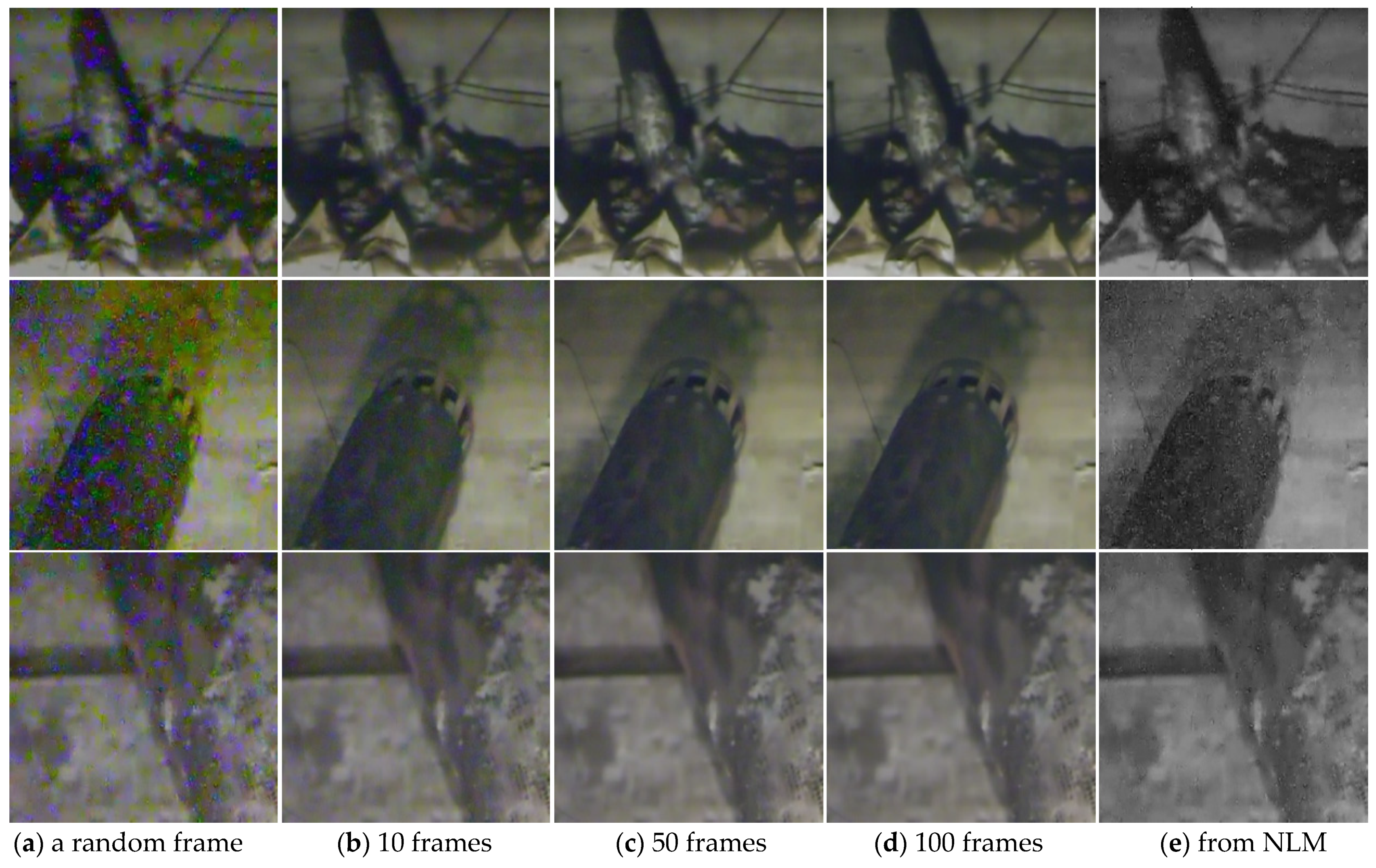
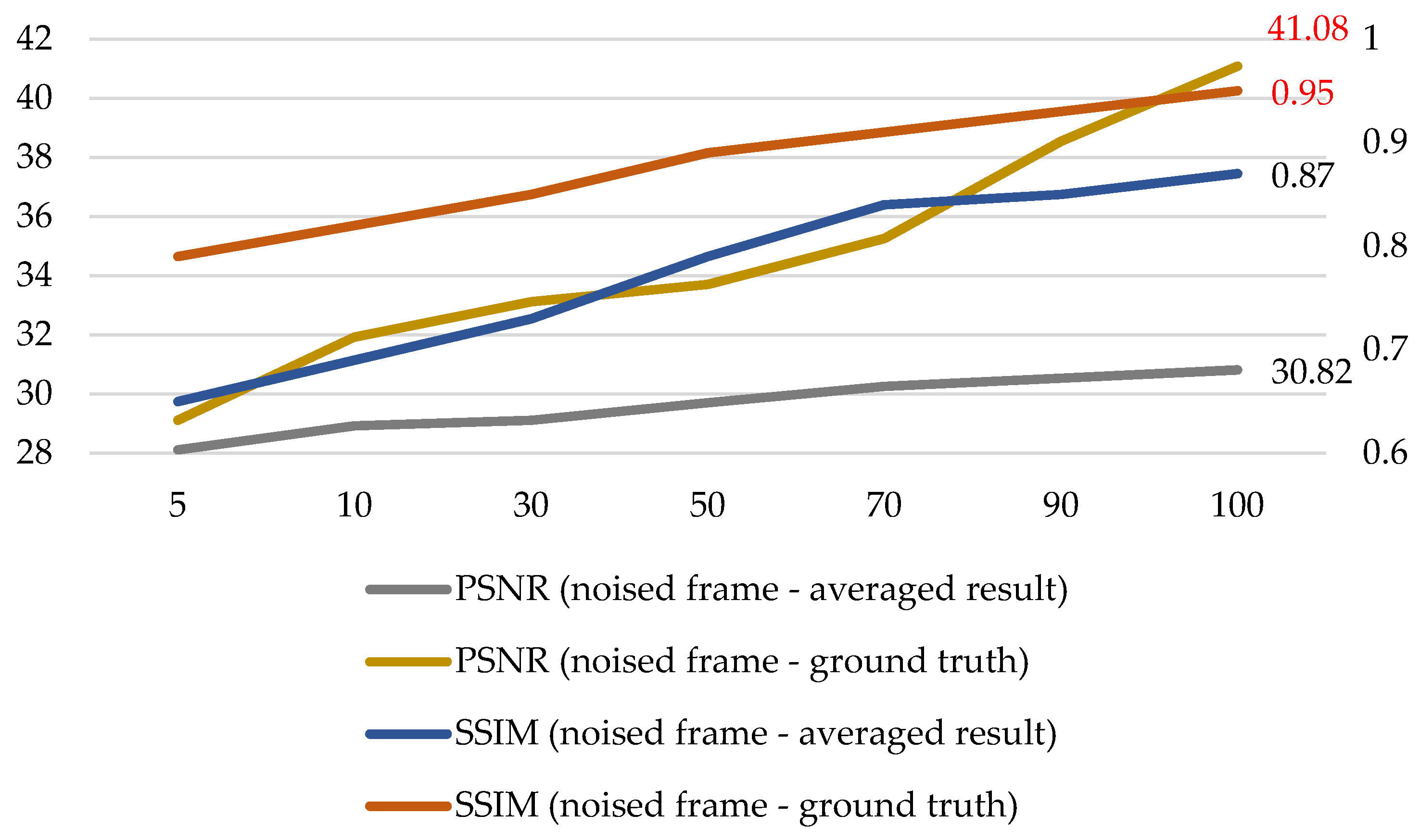


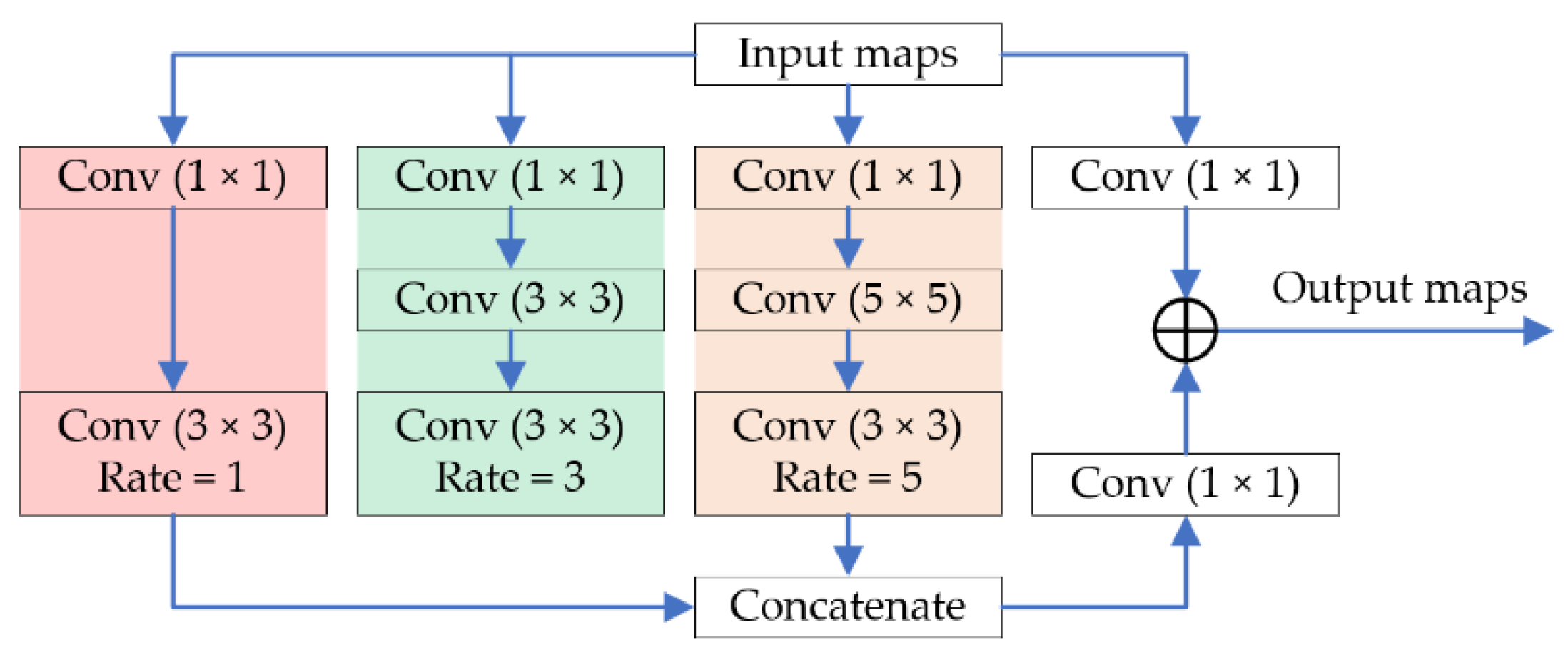



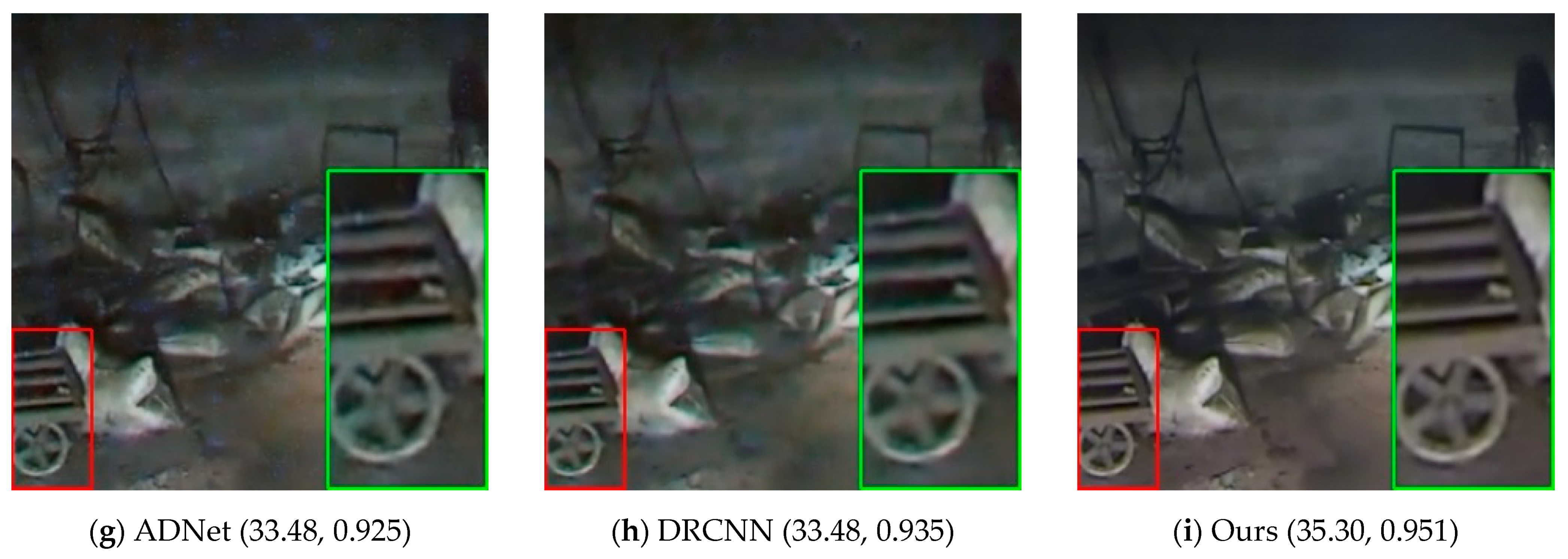
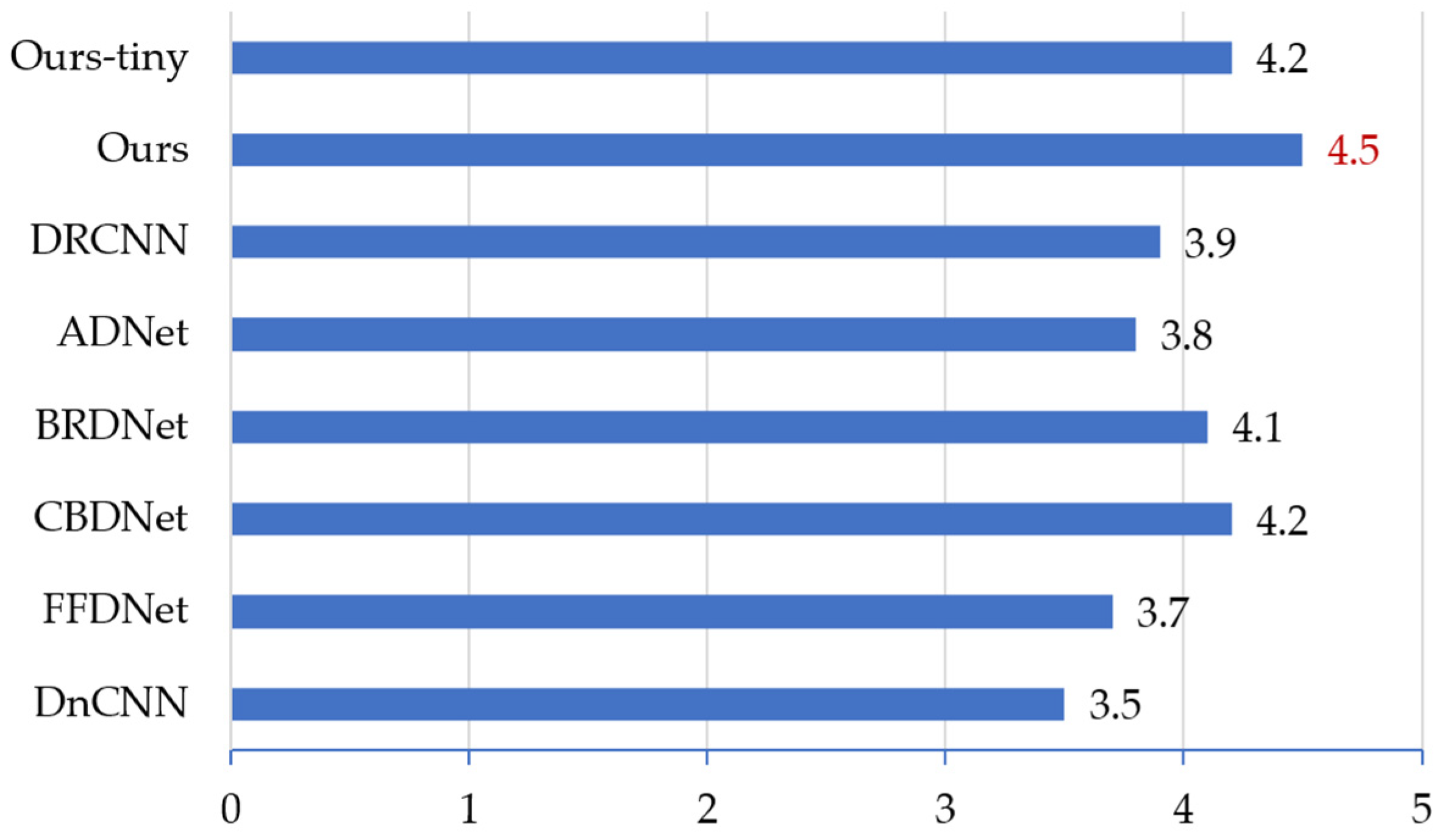

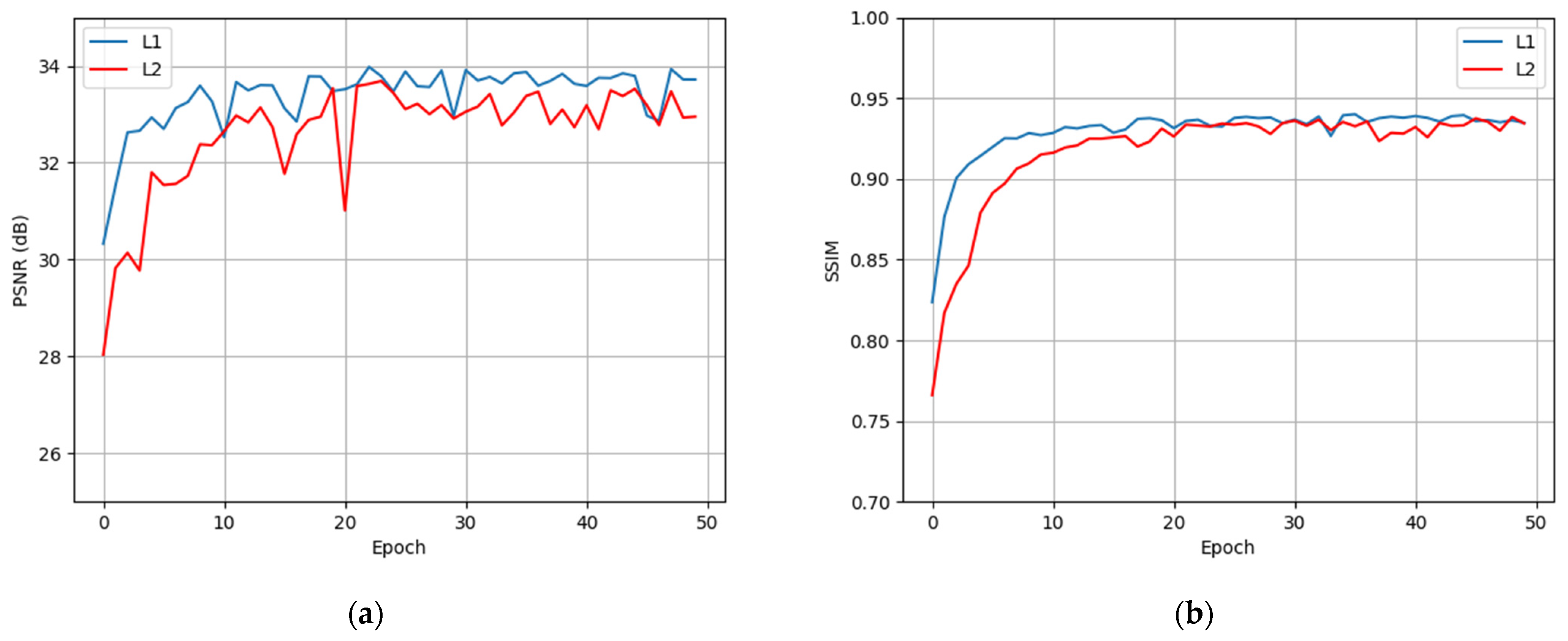


| Row | Method | FLOPs (G) | Parameters (K) | FPS | PSNR | SSIM |
|---|---|---|---|---|---|---|
| 1 | Wang [6] | - | - | 12.29 | 29.21 | 0.875 |
| 2 | Zhang [7] | - | - | 14.43 | 30.14 | 0.880 |
| 3 | Yang [8] | - | - | 13.17 | 30.33 | 0.847 |
| 4 | NLM [13] | - | - | 0.0098 | 30.85 | 0.889 |
| 5 | BM3D [11] | - | - | 0.0058 | 31.52 | 0.895 |
| 6 | WNNM [15] | - | - | 0.0012 | 31.24 | 0.899 |
| 7 | BRDNet [19] | 343.92 | 1120 | 8.06 | 32.79 | 0.922 |
| 8 | CBDNet [18] | 189.3 | 4370 | 4.97 | 33.11 | 0.927 |
| 9 | DnCNN [16] | 171.86 | 558.4 | 14.57 | 32.87 | 0.927 |
| 10 | FFDNet [17] | 65.72 | 854.69 | 14.43 | 32.03 | 0.915 |
| 11 | ADNet [20] | 160.5 | 521.49 | 12.53 | 32.12 | 0.919 |
| 12 | DRCNN [21] | 343.71 | 1120 | 12.33 | 33.01 | 0.922 |
| 13 | Ours | 68.15 | 221.76 | 14.57 | 33.81 | 0.934 |
| 14 | Our-tiny | 23.14 | 75.25 | 18.38 | 32.51 | 0.923 |
| Backbone | Channels | Layers | FLOPs (G) | PSNR | SSIM |
|---|---|---|---|---|---|
| Vanilla | 64 | 15 | 171.84 | 33.35 | 0.935 |
| MKM only | 32 | 15 | 30.66 | 33.33 | 0.938 |
| RM only | 32 | 15 | 31.92 | 33.37 | 0.936 |
| MKM–RM | 32 | 30 | 62.04 | 34.56 | 0.951 |
| Experiment | FE | RFB | AB | Mish | PSNR | SSIM |
|---|---|---|---|---|---|---|
| 1 | ✓ | 33.56 | 0.938 | |||
| 2 | ✓ | ✓ | 33.58 | 0.941 | ||
| 3 | ✓ | ✓ | 33.64 | 0.939 | ||
| 4 | ✓ | ✓ | 33.75 | 0.940 | ||
| 5 | ✓ | ✓ | ✓ | 33.29 | 0.942 | |
| 6 | ✓ | ✓ | ✓ | 33.07 | 0.941 | |
| 7 | ✓ | ✓ | ✓ | 33.62 | 0.940 | |
| 8 | ✓ | ✓ | ✓ | ✓ | 33.98 | 0.944 |
| Row | Methods | Training Time (hour) | Batch Size | Occupied GPU Memory (M) | PSNR | SSIM |
|---|---|---|---|---|---|---|
| 1 | DnCNN [16] | 6 | 128 | 5818 | 30.74 | 0.861 |
| 2 | FFDNet [17] | 6 | 128 | 5214 | 30.93 | 0.865 |
| 3 | CBDNet [18] | 6 | 128 | 6412 | 31.10 | 0.879 |
| 4 | ADNet [20] | 6 | 128 | 4172 | 31.02 | 0.874 |
| 5 | BRDNet [19] | 6 | 128 | 6374 | 31.45 | 0.877 |
| 6 | DRCNN [21] | 6 | 128 | 6512 | 30.97 | 0.880 |
| 7 | Our-tiny | 6 | 128 | 2906 | 31.07 | 0.883 |
| 8 | Our-tiny | 6 | 256 | 5214 | 31.79 | 0.894 |
| Noise Types | Gaussian | Text | Impulse | |
|---|---|---|---|---|
| Noise Levels | 25/50/75 | 25/50/75 | 25/50/75 | |
| 1 | DnCNN | 31.93/29.98/25.46 | 29.33/28.80/25.77 | 36.70/32.93/28.58 |
| 2 | FFDNet | 31.01/29.56/25.62 | 30.40/29.01/26.58 | 36.62/34.68/28.96 |
| 3 | CBDNet | 32.12/29.96/25.74 | 31.61/29.25/26.96 | 38.75/35.08/29.92 |
| 4 | ADNet | 31.11/28.66/25.62 | 30.43/28.01/25.57 | 36.62/34.68/28.66 |
| 5 | BRDNet | 32.23/30.52/25.77 | 31.18/29.35/26.17 | 38.97/35.71/29.94 |
| 6 | DRCNN | 31.11/29.66/25.62 | 30.40/28.01/26.57 | 36.62/34.68/28.81 |
| 7 | Ours-tiny | 32.31/30.44/25.71 | 31.57/29.01/27.01 | 39.04/35.51/29.82 |
| 8 | Ours | 32.41/30.54/25.78 | 32.74/29.86/27.36 | 41.21/35.74/30.86 |
| Noise Types | Gaussian | Text | Impulse | |
|---|---|---|---|---|
| Noise Levels | 25/50/75 | 25/50/75 | 25/50/75 | |
| 1 | DnCNN | 0.925/0.859/0.666 | 0.901/0.801/0.703 | 0.922/0.924/0.808 |
| 2 | FFDNet | 0.929/0.860/0.672 | 0.902/0.792/0.717 | 0.932/0.938/0.806 |
| 3 | CBDNet | 0.938/0.862/0.702 | 0.920/0.789/0.737 | 0.972/0.959/0.880 |
| 4 | ADNet | 0.929/0.856/0.701 | 0.914/0.765/0.672 | 0.937/0.935/0.836 |
| 5 | BRDNet | 0.932/0.855/0.703 | 0.926/0.828/0.729 | 0.913/0.951/0.854 |
| 6 | DRCNN | 0.938/0.854/0.701 | 0.922/0.811/0.737 | 0.962/0.953/0.826 |
| 7 | Ours-tiny | 0.938/0.860/0.704 | 0.921/0.833/0.749 | 0.978/0.955/0.879 |
| 8 | Ours | 0.940/0.866/0.713 | 0.936/0.838/0.755 | 0.983/0.960/0.882 |
Publisher’s Note: MDPI stays neutral with regard to jurisdictional claims in published maps and institutional affiliations. |
© 2021 by the authors. Licensee MDPI, Basel, Switzerland. This article is an open access article distributed under the terms and conditions of the Creative Commons Attribution (CC BY) license (http://creativecommons.org/licenses/by/4.0/).
Share and Cite
Sun, X.; Luo, H.; Liu, G.; Chen, C.; Xu, F. Lightweight Image Restoration Network for Strong Noise Removal in Nuclear Radiation Scenes. Sensors 2021, 21, 1810. https://doi.org/10.3390/s21051810
Sun X, Luo H, Liu G, Chen C, Xu F. Lightweight Image Restoration Network for Strong Noise Removal in Nuclear Radiation Scenes. Sensors. 2021; 21(5):1810. https://doi.org/10.3390/s21051810
Chicago/Turabian StyleSun, Xin, Hongwei Luo, Guihua Liu, Chunmei Chen, and Feng Xu. 2021. "Lightweight Image Restoration Network for Strong Noise Removal in Nuclear Radiation Scenes" Sensors 21, no. 5: 1810. https://doi.org/10.3390/s21051810
APA StyleSun, X., Luo, H., Liu, G., Chen, C., & Xu, F. (2021). Lightweight Image Restoration Network for Strong Noise Removal in Nuclear Radiation Scenes. Sensors, 21(5), 1810. https://doi.org/10.3390/s21051810





